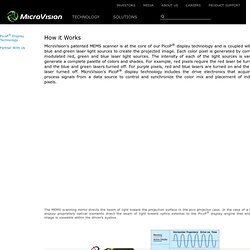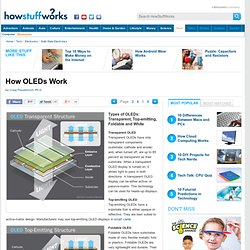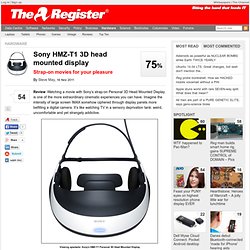

Sony announces a new 720p OLED microdisplay. Update: it turns out that the ECX332A is the same microdisplay used in Sony's HMZ-T1 HMD...

Sony released a new OLED microdisplay today, the 0.7" ECX332A which offers 1280x720 (720p) resolution. This microdisplay is aimed towards electronic viewfinder (EVF) applications and offers 97% NSTC color gamut, 0.01ms response time and 200 cd/m2 brightness. Transparent OLED « Sean Hellfritsch / Shared Feed. The folks at Fraunhofer IPMS have done it!

After years of tireless research and promises of Borg-like eyewear, the group has delivered a prototype of the world's first bidirectional, eye-tracking OLED microdisplay (got all that?) At SID 2011. The rig is much like a monocle, except with a transparent OLED display inside, which overlays digital information on top of the reflected light that usually hits your eyeballs. What's more, there are integrated photodetectors inside and special software to monitor the direction of your gaze, allowing you to interact with your newfound augmented reality using only the flick of an eyeball. Fraunhofer foresees joggers taking in movies while out for a run, which sounds more than just a little dangerous. Virtual retinal display. A diagram showing the workings of the virtual retinal display.

PicoP® Display Engine. MicroVision's patented MEMS scanner is at the core of our PicoP® display technology and is coupled with red, blue and green laser light sources to create the projected image.

Each color pixel is generated by combining modulated red, green and blue laser light sources. The intensity of each of the light sources is varied to generate a complete palette of colors and shades. For example, red pixels require the red laser be turned on and the blue and green lasers turned off. For purple pixels, red and blue lasers are turned on and the green laser turned off. MicroVision's PicoP® display technology includes the drive electronics that acquire and process signals from a data source to control and synchronize the color mix and placement of individual pixels.
The MEMS scanning mirror directs the beam of light toward the projection surface in the pico projector case. Google Glass patent application shows detailed diagrams. Along with a lot of publicity, Project Glass from Google has generated a bevy of approved patents and applications, but the latest one shows that the search giant's trying to wrap up the whole kit and kaboodle -- replete with detailed diagrams and descriptions to back it up.

Specifically, Mountain View is claiming the design of the frame itself including the bridge, brow portion, transparent display, input device plus the means for affixing everything. Transparent OLEDs" Transparent OLED Transparent OLEDs have only transparent components (substrate, cathode and anode) and, when turned off, are up to 85 percent as transparent as their substrate.

When a transparent OLED display is turned on, it allows light to pass in both directions. A transparent OLED display can be either active- or passive-matrix. This technology can be used for heads-up displays. Top-emitting OLED Top-emitting OLEDs have a substrate that is either opaque or reflective. Foldable OLED Foldable OLEDs have substrates made of very flexible metallic foils or plastics. White OLED White OLEDs emit white light that is brighter, more uniform and more energy efficient than that emitted by fluorescent lights. In the next section, we'll discuss the pros and cons of OLED technology and how it compares to regular LED and LCD technology.
Latency Mitigation Strategies. Abstract Virtual reality (VR) is one of the most demanding human-in-the-loop applications from a latency standpoint.

The latency between the physical movement of a user’s head and updated photons from a head mounted display reaching their eyes is one of the most critical factors in providing a high quality experience. Human sensory systems can detect very small relative delays in parts of the visual or, especially, audio fields, but when absolute delays are below approximately 20 milliseconds they are generally imperceptible. Interactive 3D systems today typically have latencies that are several times that figure, but alternate configurations of the same hardware components can allow that target to be reached. Zeal Optics - Official Website. Monocular HMD'S - Rugged Head Mounted Displays by BFi OPTiLAS. ST1080, HMD, HD Projector, LCoS, 1080p Projector, 4k2k. Sony HMZ-T1 3D head mounted display. Review Watching a movie with Sony’s strap-on Personal 3D Head Mounted Display is one of the more extraordinary cinematic experiences you can have.

Imagine the intensity of large screen IMAX somehow ciphered through display panels more befitting a digital camera. It’s like watching TV in a sensory deprivation tank: weird, uncomfortable and yet strangely addictive. Viewing spectacle: Sony's HMZ-T1 Personal 3D Head Mounted Display Not that I’ve worked out who would actually want to buy a HMZ-T1 headset and I suspect Sony hasn’t either. Only a limited number are shipping into the UK (an unofficial source – actually a salesman working in the Harrods Sony Centre - told me it could be as low as 250 units, which may or may not be true); at £800 Sony clearly doesn’t consider it a mass market proposition. Sony has dabbled with video headsets before – congratulations if you have a Glasstron in your loft, circa 1997, it’s probably worth a mint by now – but this is radically different.